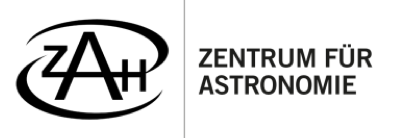Astronomisches Rechen-Institut
Address:
Astronomisches Rechen-Institut
Mönchhofstr. 12-14
69120 Heidelberg
Germany
Directions
The Astronomisches Rechen-Institut (ARI) is part of the newly established Centre for Astronomy of Heidelberg University (Zentrum für Astronomie der Universität Heidelberg or ZAH). The other two institutes in the ZAH are the Institute for Theoretical Astrophysics (Institut für Theoretische Astrophysik or ITA) and the State Observatory Königstuhl (Landessternwarte Königstuhl or LSW).
The scientific activities at the ARI cover a broad range of research areas including cosmology, gravitational lensing, galaxy evolution, star clusters, stellar astrophysics, the interstellar medium, astrometry, satellite missions, and calendrical calculations.
The ARI is involved in various national and international scientific networks and collaborations. The institute plays a leading role in supporting the Gaia satellite mission of the European Space Agency and participates in the ground-based spectroscopic and photometric SDSS, 4MOST, and LSST surveys.
